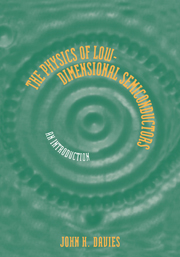Book contents
- Frontmatter
- Contents
- Preface
- Introduction
- 1 FOUNDATIONS
- 2 ELECTRONS AND PHONONS IN CRYSTALS
- 3 HETEROSTRUCTURES
- 4 QUANTUM WELLS AND LOW-DIMENSIONAL SYSTEMS
- 5 TUNNELLING TRANSPORT
- 6 ELECTRIC AND MAGNETIC FIELDS
- 7 APPROXIMATE METHODS
- 8 SCATTERING RATES: THE GOLDEN RULE
- 9 THE TWO-DIMENSIONAL ELECTRON GAS
- 10 OPTICAL PROPERTIES OF QUANTUM WELLS
- A1 TABLE OF PHYSICAL CONSTANTS
- A2 PROPERTIES OF IMPORTANT SEMICONDUCTORS
- A3 PROPERTIES OF GaAs–AlAs ALLOYS AT ROOM TEMPERATURE
- A4 HERMITE'S EQUATION: HARMONIC OSCILLATOR
- A5 AIRY FUNCTIONS: TRIANGULAR WELL
- A6 KRAMERS–KRONIG RELATIONS AND RESPONSE FUNCTIONS
- Bibliography
- Index
3 - HETEROSTRUCTURES
Published online by Cambridge University Press: 05 June 2012
- Frontmatter
- Contents
- Preface
- Introduction
- 1 FOUNDATIONS
- 2 ELECTRONS AND PHONONS IN CRYSTALS
- 3 HETEROSTRUCTURES
- 4 QUANTUM WELLS AND LOW-DIMENSIONAL SYSTEMS
- 5 TUNNELLING TRANSPORT
- 6 ELECTRIC AND MAGNETIC FIELDS
- 7 APPROXIMATE METHODS
- 8 SCATTERING RATES: THE GOLDEN RULE
- 9 THE TWO-DIMENSIONAL ELECTRON GAS
- 10 OPTICAL PROPERTIES OF QUANTUM WELLS
- A1 TABLE OF PHYSICAL CONSTANTS
- A2 PROPERTIES OF IMPORTANT SEMICONDUCTORS
- A3 PROPERTIES OF GaAs–AlAs ALLOYS AT ROOM TEMPERATURE
- A4 HERMITE'S EQUATION: HARMONIC OSCILLATOR
- A5 AIRY FUNCTIONS: TRIANGULAR WELL
- A6 KRAMERS–KRONIG RELATIONS AND RESPONSE FUNCTIONS
- Bibliography
- Index
Summary
This chapter provides a review of the general properties of heterostructures, semiconductors composed of more than one material. Variations in composition are used to control the motion of electrons and holes through band engineering. Knowledge of the alignment of bands at a heterojunction, where two materials meet, is essential but has proved difficult to determine even for the best-studied junction, GaAs–AlxGa1−xAs. Although effort was initially concentrated on materials of nearly identical lattice constant, current applications require properties that can be met only by mismatched materials, giving strained layers.
A huge variety of devices has been fabricated from heterostructures, for both electronic and optical applications, and we shall survey these before studying them in greater detail in later chapters. Finally, we shall look briefly at the effective-mass approximation. This is a standard simplification that allows us to treat electrons as though they are free, except for an effective mass, rather than using complicated band structure. It means, for example, that an electron in a sandwich of GaAs between Al0.3Ga0.7As can be treated as the elementary problem of a potential well.
We shall neglect the random nature of alloys such as AlxGa1−xAs, where there is assumed to be no ordering of the Ga and Al ions over the cation sites of the lattice. In principle Bloch's theorem does not apply to such materials because they lack translational invariance from cell to cell.
- Type
- Chapter
- Information
- The Physics of Low-dimensional SemiconductorsAn Introduction, pp. 80 - 117Publisher: Cambridge University PressPrint publication year: 1997



